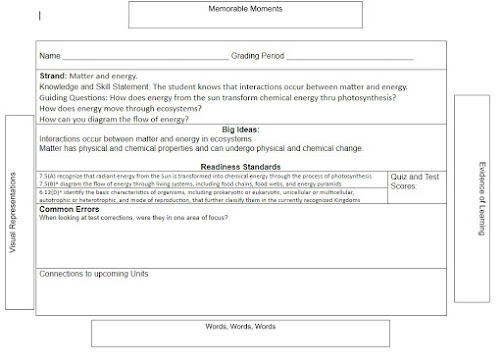Hey Fast Llamas!
Last week, we talked about a "learner-friendly culture" and I mentioned "learning maps" as a way increase student and content connections. Let's take a deep dive with this strategy, in which we use our content to make our learning outcomes, expectations and our clarity of purpose more visible to students.
A Learning Map is a graphic organizer showing all of the skills and ideas students are to learn in a unit. Students use learning maps to review, monitor their learning and gain confidence in what they have learned. Teaching students how to set goals, reflect on their learning and use the feedback they are receiving to improve their learning are all good practices. We are teaching "learning how to learn" principles and it is so good for students. Teachers can use learning maps to ensure clarity which has a high effect size.
Here is an example of one for a 7th grade science unit "Biointeractions".
Learning maps can also be drawn like a concept map.
Why bother? Learning maps are useful because they provide a visual depiction of a unit that keeps everyone on track and they can be utilized as a study guide as well. Teachers should devote about 35 minutes at the beginning of a unit to introduce the unit by modeling it with students. Throughout the unit, teachers and students revisit the map to see how their progress is going, recording new learning as needed. At the end of the unit, students have built their own study guide. Learning maps teachers skills in goal writing, note taking, feedback, reflection, and ownership of learning. It also increases the connections students have to the content and their own learning. Teachers benefit with reflection of their own clarity of learning targets and goals. Learning maps are intended take students from point A (the beginning of the unit) to point B (the end of the unit), with interactions with the learning along the journey.Tips:
1. be sure to answer the guiding questions otherwise remove them
2. learning maps are one page only
3. show connections
4. organized with the sequence of the unit
5. revisit Big Ideas often
Lastly, there is a commitment to this concept that needs some "sticktoitness". We often lose sight of the "why" due to time constraints. Honestly, I came to Labay in my role 5 years ago, blazing to do these with teachers and students, and time was always an issue. I also can reflect that with the MLD the district provides, these seemed an over abundance of information. I have many learning maps (which I unfortunately called Anchor Charts) that are written and are not being utilized at the moment. However, after revisiting Jim Knight's work on this strategy, I have come to embrace it once again. This is definitely a strategy to keep in mind as we move forward this year, as student connections are more important than ever. Try learning maps... you just might like them!






No comments:
Post a Comment
Join in the conversation: